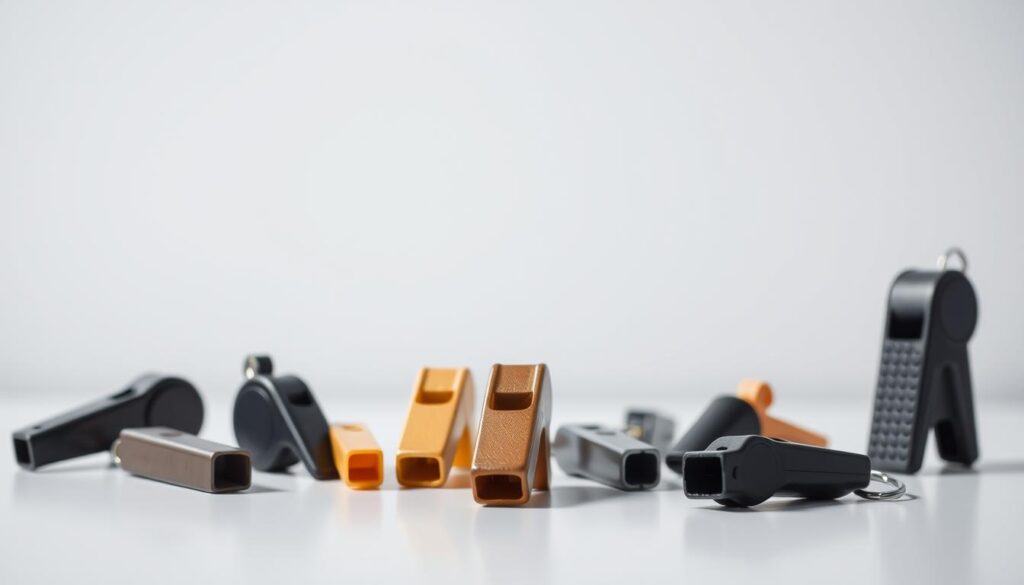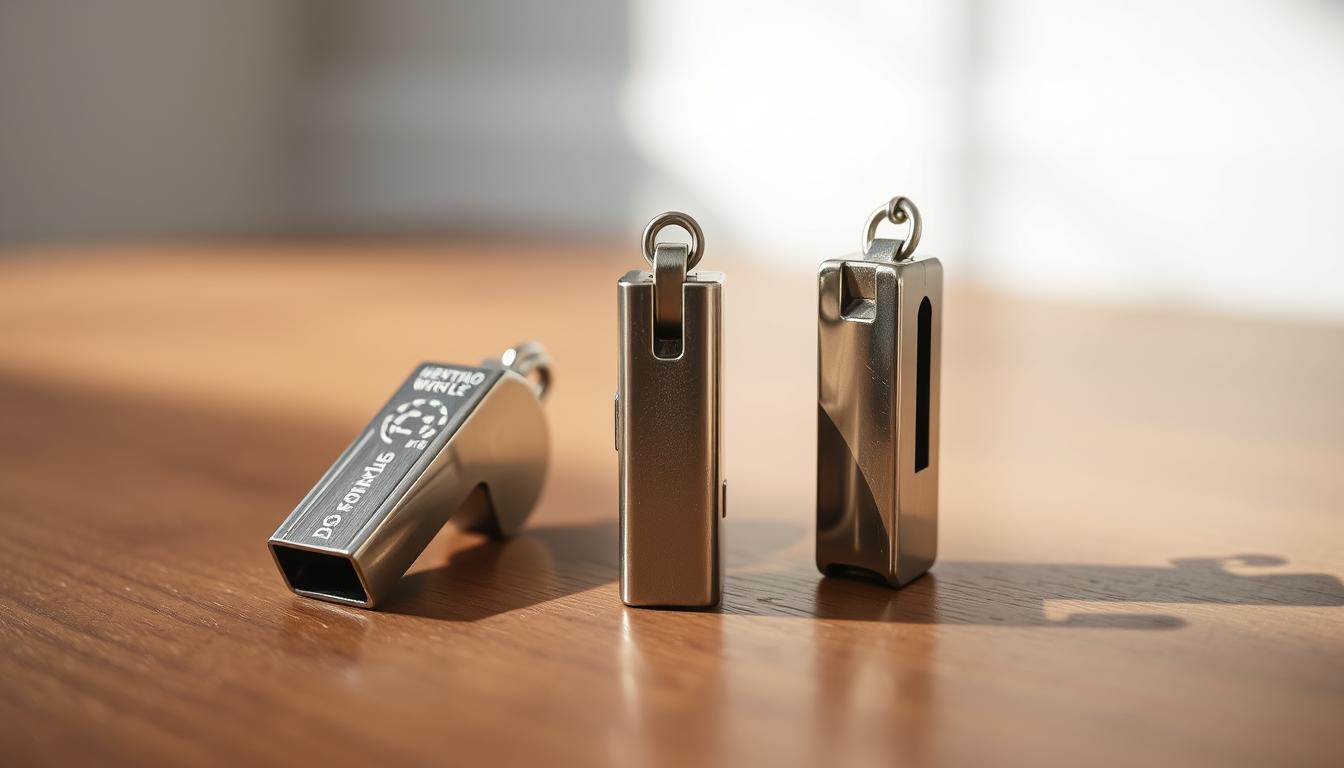For many dog owners, dealing with too much barking is a big challenge. It can make the relationship between pet and owner tough. The dog whistle has become a popular solution to this problem. But how well do these whistles really work, and what’s their part in barking control?
Ultrasonic whistles have caught a lot of attention. They’re said to be heard by dogs but not by people. While they’re not a quick fix, dog whistles can help in training. They’re great for recall training and getting a dog’s attention.
Knowing how dog whistles function and their limits helps dog owners use them better. They can be a key part of a training plan to handle barking.
Understanding Dog Whistles and Barking Behavior
Dog whistles work because dogs hear sounds differently than humans. They can hear a wider range of sounds, which is important for controlling barking.
Frequency Range Dogs Can Detect
Dogs can hear sounds from 40 Hz to 60,000 Hz. Humans can only hear sounds from 20 Hz to 20,000 Hz. This means dog whistles can get a dog’s attention better.

Dogs and humans hear sounds in different ways. Dogs can find the source of a sound more easily. They also hear higher frequencies better. This is why silent dog whistles work well for dogs without bothering humans.
Key differences in sound processing between dogs and humans include:
| Characteristic | Dogs | Humans |
|---|---|---|
| Frequency Range | 40 Hz to 60,000 Hz | 20 Hz to 20,000 Hz |
| Sound Localization | More acute ability to pinpoint sound sources | Less sensitive to high-frequency sounds |
| Sensitivity to High-Frequency Sounds | Very sensitive, can detect ultrasonic sounds | Not sensitive to frequencies above 20,000 Hz |
Knowing these differences helps use dog whistles better for training and controlling barking.
Types of Dog Whistles Available on the Market
Dog owners have many options when it comes to dog whistles. They can choose from ultrasonic models that humans can’t hear. This variety helps owners pick the best tool for their training needs.
There are many dog whistle brands out there, each with its own features and benefits. ACME is a well-respected brand in the dog training world. They are known for making high-quality whistles.

The Ultimate Silent Dog Training Whistle is a favorite among professional dog trainers. The ACME 535 silent dog whistle is also highly valued. It’s known for its reliability and effectiveness.
Frequency Ranges and Adjustability
Dog whistles come in different frequency ranges. Some have fixed frequencies, while others can be adjusted. The ability to adjust the frequency is very useful.
It lets trainers tailor the whistle to their dog’s specific needs. This makes the training process more effective.
Different Dog Whistles And Their Effect On Barking Control
Knowing how different dog whistles work is key for dog owners with barking issues. The right whistle depends on the dog’s traits, breed, age, and training history.
Dog whistles make sounds dogs can hear but humans can’t. But, how dogs react to these sounds varies by breed and age.
Small vs. Large Breed Responses
Studies show small and large breeds react differently to dog whistles. Small breeds are more sensitive to high sounds, making them quicker to respond to certain whistles.
- Small breeds like Chihuahuas and Poodles quickly react to high-pitched whistles.
- Large breeds, such as German Shepherds and Labradors, might need a different sound or consistent training.
Dogs’ physical traits and history affect their response to whistles. For example, some small breeds were bred for alertness, making them more sensitive to high sounds.

A dog’s age also matters in its response to a dog whistle. Younger dogs are more open to new sounds and training, making them more likely to respond to a whistle.
- Puppies can start learning with whistles early, helping them behave well.
- Older dogs might need more time and patience, as they’re less likely to respond to new things.
Consistency and positive feedback are crucial in training dogs of any age. Knowing these age differences helps owners tailor their training for better barking control.
In summary, the success of dog whistles in controlling barking depends on breed and age. By understanding these factors, owners can pick the best whistle and training approach for their dog.
How to Choose the Right Dog Whistle for Your Situation
Dog whistles come in different types, and the right one depends on where you live.
Choosing the right dog whistle is key for controlling barking and training. Your living situation is a big factor in picking the best one.
Apartment Living Considerations
If you live in an apartment, you need a dog whistle that won’t disturb your neighbors.
Ultrasonic dog whistles are perfect for apartment dwellers. They’re silent to humans but work well for dogs.
Neighborhood and Noise Restrictions
In places with noise rules, picking a dog whistle that meets local laws is crucial.
A table comparing different dog whistles can help you decide:
| Type of Dog Whistle | Loudness | Suitability for Apartment Living |
|---|---|---|
| Ultrasonic | Silent to humans | Highly suitable |
| Pealess | Adjustable | Suitable with adjustments |
| Traditional | Loud | Less suitable |

Think about your living situation and the best dog whistle for it. This way, you can better control barking and train your dog.
Proper Techniques for Using Dog Whistles
Using dog whistles right is key to successful training. You need to know how to use them well in your training plan. This avoids any bad effects.
Correct Usage is crucial for dog whistles. It’s not just about blowing the whistle. It’s about doing it in a way that’s clear and consistent to your dog. You must understand how dogs react to the whistle.
Overuse and Desensitization
One big problem with dog whistle training is using them too much. This can make the whistle less effective. To prevent this, trainers should:
- Only use the whistle when it’s really needed.
- Change the pitch or pattern of the whistle to keep the dog interested.
- Give the dog a treat when they respond to the whistle, making it more meaningful.
Inconsistent Command Associations
Another important thing is to make sure the commands with the whistle are the same. If the commands are different, it can confuse your dog. To keep things consistent:
- Choose a clear and specific command for the whistle.
- Make sure everyone training your dog uses the same command and whistle method.
- Give your dog time to learn and understand the whistle and command.
By following these tips, you can make your dog whistles work better. This will help control barking and strengthen your bond with your dog.
Creating an Effective Training Program with Whistles
Using dog whistles can really help control barking in dogs. The secret to success is being consistent and using positive rewards.
Consistency is key when training with a whistle. Always use the whistle in the same way to avoid confusing your dog.
Treat-Based Rewards
Using treat-based rewards is a great way to encourage good behavior. Give your dog a treat when they stay quiet after hearing the whistle. This teaches them the whistle means quiet time.
Change up the treats to keep things exciting and prevent boredom. A variety of small, tasty treats works well.
Verbal and Physical Praise
Verbal and physical praise also help reinforce good behavior. When your dog responds well to the whistle, praise them. This motivates them to keep up the good work.
Adding physical affection, like pats or hugs, to your praise strengthens your bond. This makes training more effective.
By using these methods, you can build a solid training program for barking control. Always be patient and consistent for the best results.
Potential Limitations and Ethical Considerations
Dog whistles are not a magic fix for barking problems. They have their own limits and ethical issues. They work well when you know why your dog is barking.
Medical Causes of Barking are often missed when using dog whistles alone. Barking can signal pain, anxiety, or brain problems. Research shows that finding and fixing the real cause is key. So, always check with a vet before starting a training plan with dog whistles.
Medical Causes of Barking
- Pain or discomfort
- Anxiety or stress
- Cognitive decline
Deeply Ingrained Behavioral Issues
Dog whistles might not work for dogs with serious behavioral problems. For these cases, a detailed training plan is needed. This could include professional dog training or behavior therapy.
In summary, dog whistles can help with barking, but they’re not perfect. Knowing the real reason for barking and tackling it right is crucial. This way, dog owners can manage barking in a kind and effective way.
Alternative Methods for Barking Control
There are many ways to control barking beyond dog whistles. These methods can be used alone or with dog whistles for better results.
Citronella Collars
Citronella collars are a great alternative to dog whistles. They release a burst of citronella spray when the dog barks. This startles the dog and stops the barking. The main benefit of citronella collars is they stop barking without hurting the dog.
Ultrasonic Stationary Devices
Ultrasonic devices make a sound dogs don’t like but humans can’t hear. They detect barking and send out the sound to stop it. These devices are good for barking caused by outside noises.
Creating a calm environment also helps reduce barking. This means reducing exposure to things that make dogs bark and making a peaceful space. You can use calming music or white noise machines.
Exercise and Mental Stimulation
Barking can mean a dog is bored or has too much energy. Giving dogs enough exercise and mental challenges can help. This includes longer walks, playtime, and puzzle toys.
In summary, there are many ways to manage a dog’s barking. By trying these methods, owners can make a better home for their pets.
Conclusion
Understanding dog whistles and their impact on barking is key for effective training. There are many types of dog whistles, each with its own benefits. Choosing the right one is crucial for the best results.
Controlling barking goes beyond just using dog whistles. It also means addressing why dogs bark and using proper training. Since dog whistles work differently for each dog, a custom approach is needed.
Using dog whistles along with training and understanding why dogs bark can greatly improve control. This approach helps owners solve the barking problem effectively. It leads to a better relationship between dogs and their owners.






